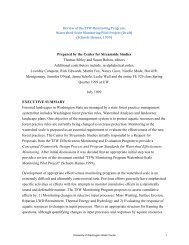Copyright 2012 Aileen M. Echiverri-Cohen - University of Washington
Copyright 2012 Aileen M. Echiverri-Cohen - University of Washington
Copyright 2012 Aileen M. Echiverri-Cohen - University of Washington
You also want an ePaper? Increase the reach of your titles
YUMPU automatically turns print PDFs into web optimized ePapers that Google loves.
Data Analytic Strategy<br />
Treatment Modality and Time. To compare individuals treated with sertraline to those<br />
treated with prolonged exposure on changes in inhibitory functioning, as measured by AB and<br />
PPI, from pre- to post-treatment, random effects modeling was conducted comparing change in<br />
inhibition in SER and PE. Specifically, the dependent variables were AB at Lags 1-5 and PPI at<br />
three lead intervals (30, 60, 120 ms) were examined.<br />
Responder Status and Time. Next, to compare individuals who responded more to<br />
treatment to those who responded less to treatment on changes in inhibitory functioning, as<br />
measured by AB and PPI, from pre- to post-treatment, random effects modeling was conducted.<br />
To measure treatment responder status, change scores from pre to post treatment on PSSI to<br />
examine changes in inhibition as part <strong>of</strong> treatment, was grand mean centered to provide an<br />
interpretable zero point (Gallop & Tasca, 2009). Specifically, AB at Lags 1-5 and PPI at three<br />
lead intervals (30, 60, 120 ms) were examined.<br />
Predictors <strong>of</strong> Trauma-Related Symptoms. To examine the ability <strong>of</strong> pre-treatment<br />
inhibitory functioning, as measured by AB and PPI, to predict changes in trauma-related<br />
psychopathology (i.e., anxiety, depression, dissociation), disability, and treatment dropout from<br />
pre- to post-treatment and from pre-treatment to 3-months follow-up, mixed model regressions<br />
were used to examine change scores in anxiety (STAI-T), depression (BDI), dissociation (DES),<br />
functioning (SDS), and treatment drop-out from pre- to post-treatment and pre- to follow-up as<br />
dependent variables and pre-treatment scores on lags 1-5 in AB and short lead intervals 30, 60,<br />
120 ms in PPI as independent variables were performed. The dependent variables were PTSD<br />
severity (PSS-I), depression (BDI), trait anxiety (STAI-T), dissociation (DES), functioning<br />
33
















